2017年12月16日(土)
會津卓也さんが考えるインディーの魅力とは!? ダウンロードタイトルの市場やメリットとデメリットを語る
さまざまなタイトルを開発するインティ・クリエイツの代表取締役社長である、會津卓也さんへのインタビューを実施。
→translated English version from here.(英訳版)
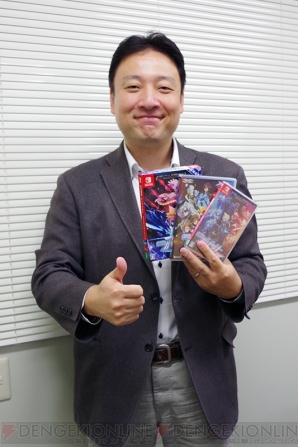
|
|---|
インティ・クリエイツは、2016年で創立20周年を迎えたゲーム開発会社。ディペロッパーとしてさまざまなタイトルを手がけるだけでなく、最近では自社タイトルの販売、配信を行っている。
會津さんには、インディーゲームや市場を広げるダウンロードタイトルについて語っていただいた。同社がてがけるタイトルの開発経緯やファンとのふれあいなどについても迫っているので、同社のファンだけでなく、ダウンロードタイトルについて興味がある人はご覧いただきたい。
ダウンロードタイトルは市民権を得ている……現在の市場を語る
――インディーゲームとひと言に言ってもいろいろなタイトルがあります。いろいろな考え方はあるのですが、どのようにとらえていますか?
一言で“インディー”と言っても、くくりの幅が広いんですよね。でも私は、その曖昧としたところがインディーのよさだと思っています。
例えば、ずっとコンシューマのデベロップメントをやっていた会社が、自分たちで開発して出した場合、確かに開発力はあるからクオリティは高くなります。弊社のようにチームでやっているところもあれば、1人でソースを作ってモバイルで販売している方もいらっしゃいますね。それらすべてを含めてインディーって言っていいんじゃないかなと私は思います。
――当たり前かもしれませんが、インティ・クリエイツのタイトルはクオリティが高いですね。
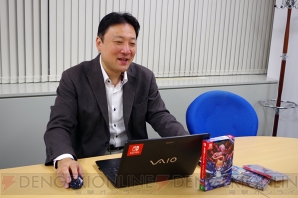
|
|---|
ありがとうございます。弊社はAAA(トリプルエー)タイトルを作っている会社ではありません。受託で開発しているものは、低年齢層向けのものが多いです。ですので、低年齢層に向けて丁寧に作ることを心がけています。
ゲーム業界の顧客として、今後支えていってくれる人を育てないと、業界自体がなくなってしまうという危機感がすごくあって、小さい子に向けて出すようなゲーム……まあ、『ぎゃる☆がん』なんかは違うんですけど(笑)、そういうターゲットに向けたゲームを作りたいなと思っていて、受託はそちらを中心にやっています。
――ターゲットはわかりやすいですが、ちゃんとそこに届けるのは大変というイメージがあります。
小さい子に訴求するのは難しく、テレビCMとか雑誌タイアップとかお金がかかるプロモーションをいろいろする必要があります。そのため、インディーでやるのは大変ですね。インディーは、どちらかといえば年齢の高い人向けでタイトルを出しています。
――現状のダウンロードタイトルの市場を、どのようにとらえていますか?
とっくに市民権は勝ち得ていると思っています。今でもパッケージソフトを好まれるユーザーがいる中で、これだけダウンロードタイトルが売れてきているというのは、垣根をなくした要因があると思っています。私はその要因の1つとしてはスマートフォンがあると思っています。
――アプリでしょうか?

|
|---|
そうですね。スマートフォンのゲームはパッケージがなく、すべてダウンロード販売じゃないですか。アプリのダウンロードはOKだと思っている人は、「じゃあコンソールのダウンロードはダメなの?」という考えに徐々になってきても不思議ではありません。人によりますが、その垣根が曖昧になってくるタイミングは必ずあると思います。
さらにですが、Nintendo Switchなどの携帯ゲーム機が特にそうだと思うのですが、持ち運んでいる時や遊んでいる時にカートリッジやCD-ROMを入れ替えるのは手間じゃないですか。
――ああ、わかります。
ダウンロードしていれば、いつでもどこでも起動できて遊べます。あと、立ち上げて少しだけゲームをして終えるような、毎日ちょっとずつやることに意味があるタイトルの場合もダウンロードのほうがいいと思うんですよね。
そういったタイトルもある程度成功しているものがあることを考えると、ダウンロードタイトルは市民権を得ていると思っています。そして、これからも伸びていくと思います。
――個人的にはPS Vita以降、いろいろなタイトルを入れたいので大きめのメモリを買うケースが増えました。
ちょっと別の話ですが、最近のゲームはどれも容量が大きいですよね。弊社が作っている『マイティガンヴォルト バースト』は40MBくらいしかないですよ。メガバイトですよ(笑)。まあ、『マイティガンヴォルト バースト』は、弊社の新エンジンでやっているため、容量がかなり少なくできているのですが、
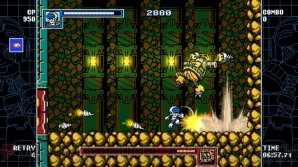
|
|---|
| ▲『マイティガンヴォルト バースト』 |
『ブラスターマスター ゼロ』は280MBくらいはあります……作るジャンルにもよりますが、インディーゲームであれば、64GBとか128GB程度のSDカードがあれば余裕だと思いますね。もちろん3DゴリゴリのAAAタイトルであれば、もっと容量は必要だと思いますが。
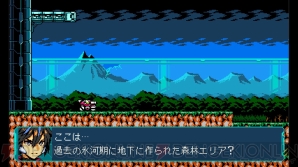
|
|---|
| ▲『ブラスターマスター ゼロ』 |
ダウンロードタイトル配信のきっかけはユーザーの笑顔
――先ほどの話ですが、スマートフォンが登場した段階から、市場が変わっていくという考えがあったのでしょうか。
少なからず変化はあるだろうと思いました。スマートフォンの市場が伸びていくに従って、コンソールの市場がシュリンクしていくというのは誰もが思っていた未来ですし、実際にそうなっています。
そうすると販売店は減っていき、ユーザーが店頭でソフトを買える環境が減っていく。無論ネット通販はあるのですが、そういった流れの中でダウンロード販売を買う機会が増えていくと考えました。
もうひとつはネット接続率が上がっていることが関係していると考えています。ユーザーが感じていたダウンロードに対する垣根が取っ払われていき、市場が確立していくだろうと薄々思っていました。ただそれほど確固たる自信があったわけではないです(笑)。
――どこかで「ダウンロードタイトルはいけそうだ」と思ったタイミングはあった?
アメリカのSteamを見た時ですね。やや前ですが、Steamの流れがすごくあって、「Steamで出せばだいたい売れます」と言われていた時期がありました。PCゲームはダウンロードで買っている人がすごく多いということです。
ちょうど2013年に、シアトルで行われたPAX Primeに稲船敬二さんと一緒に行って、Kickstarter(キックスターター)で『Mighty No.9』を立ち上げたんですけど、その時にIndie MEGABOOTHを訪れたのですね。そうしたら昔懐かしい日本のゲームにソックリなタイトルがたくさん並んでいて、しかもそれをみんなが「これ買う!」、「いいね!」と楽しそうにコミュニケーションを取っていたんです。そのタイトルをどこで売っているかというと、Steamだったんですね。
このころ、ニンテンドー3DSで『蒼き雷霆(アームドブルー) ガンヴォルト』を作っていました。弊社はPC上で作ったものをニンテンドー3DSに移植するのではなく、ニンテンドー3DSのターゲット上でソフトを開発するんです。そのため、デモンストレーションで開発中のゲームのPC版を見せてほしいと言われても見せられないのが普通です。なので、Steamと言う販売方法は難しかったんです。
※Kickstarter(キックスターター):ウェブを介して、新たなプロジェクトに共感する人から資金を集める手法。
――そうだったんですね。
Steam上で昔懐かしタイプのゲームを作って、売って、買う環境があることを確認できましたがSteamで売るのは難しい。しかしそこで、『ショベルナイト』は、3DSのダウンロード版ですごく売れていることを聞いたので、「ならば『ガンヴォルト』を3DSのニンテンドーeショップで売ってみよう」と決めて、売り出すことにしました。
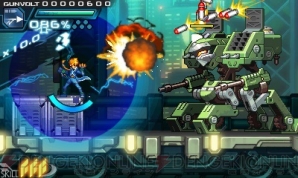
|
|---|
| ▲『蒼き雷霆(アームドブルー) ガンヴォルト』 |
――発表した時にユーザーからどういう反応がありましたか?
『ガンヴォルト』が発表された時は、大手メーカーから横スクロールタイプの2Dアクションがしばらく出ていなかったタイミングだったんですよね。そういう状況の中で、弊社はそのジャンルを作ってきた経歴があったので、すごく注目を集めました。
特に海外、アメリカでは、そのジャンルのファンが非常に多いこともあって、反響がすごかったです。ある程度の想定はしていたんですけど、ちょっとビックリしました。
――個人的な印象ですが、ディープなファンが多いジャンルというイメージです。
そうです。ただ、そのディープなユーザーは全世界に一定数いらっしゃるんですね。
例えばNintendo Switchのローンチで出した『ブラスターマスター ゼロ』は、私の知り得る限り、北米、欧州、日本と地域別に出荷しているNintendo Switchの分布と同じようなリージョン分布で売れていると分析しています。
そのため、「日本だからすごく売れてる」や「北米、欧州だからすごく売れている」というよりは、ちょっとレトロなタイプのゲームファンは、各地域に一定割合いて、その割合はその地域も変わらないと認識しています。
――『ガンヴォルト』ですが、1作目が好評だった反面、2作目が伸びなかったというのを見た記憶があるのですが……国内海外ともに厳しいのでしょうか?
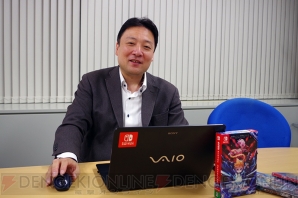
|
|---|
ああ、“Tokyo Indie Fest”の話ですね。それなんですが、話が一人歩きしちゃっているので説明できればと思います。国内の販売数を見ると『ガンヴォルト爪』は売れているんですね。ストーリーものの続編は、前作の7割くらい売れれば成功と思っているのですが、そういう視点から見るとそれ以上にと売れています。安心してください。
実は“Tokyo Indie Fest”で公聴されていた方は、ほとんど海外の方だったんですね。そのため、日本国内向けというよりは、どちらかといえば日本在住なんだけどネイティブアメリカンの人やTwitchで見ている方など、グローバルな視点の講演でした。そんなこともあって、国内の販売事情ではなく、海外の販売事情について私が触れました。
海外を見てみると、特にニンテンドー3DSは2016年にはかなり失速していました。そのため、2014年と2016年の3DSの市場は、かなり違うんですよ。そのような背景もあって、ニンテンドーeショップで販売しているタイトルとしては苦戦したと感じていたので、あのような講演をしました。
――そうだったんですね。
海外市場はPS4は伸び盛りです。そんなこともあり、『ぎゃる☆がん だるぶぴーす』の海外版に関しては相対的に売れているデータがあるんです。当時はPS4だけでなく、PS Vitaもそれなりに売れていましたね。さすがに海外でPS Vitaは動かなくなりましたが、PS4版は今でも売れています。
ただ、もちろん『ガンヴォルト』の低迷はハードのせいだけではないとは思っています。一方の『ぎゃる☆がん』に関してはハードのおかげで売れていると思っています。あと海外のクリエイターはああいうタイプのゲームを作らないじゃないですか?
――確かに見ないですね。
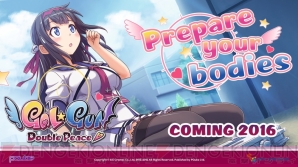
|
|---|
そうなんですよね。だから海外にああいうタイプのゲームが何のフィルタもなく移植されるという意味では目新しさがあるのかなと思っています。イギリスのPQube(ピーキューブ)さんがパブリッシャーで売ってくれたのですけど、かなり彼らが頑張ってくださったので、感謝しています。
――今回『2』も一緒にタッグを組まれていますね。
はい、今回もタッグを組んでやっています。ホームページの方にもPublished by PQubeと書いてあるんで、気づいていらっしゃる方は気づいていると思います。
『ブラスターマスター ゼロ』発売にこぎつけたのは奇跡が重なったため!?
――『ブラスターマスター』は海外で人気のタイトルなので、国内よりも海外がメインターゲットになっていると思っていたでのすが、国内でも同様にダウンロードされているのでしょうか?
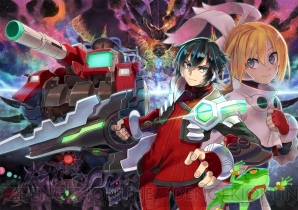
|
|---|
予想していたように、一定数ダウンロードされています。国内では『メタファイト』という名前で出せばもう少しダウンロードされたかもしれないのですが、これは版元であるサンソフト(※サン電子株式会社のブランド名)さんとの協議で決めたことです。最終的にタイトル名をどうするかを決める時に、国内は『メタファイト ゼロ』、海外は『ブラスターマスター ゼロ』とすると、情報に敏いユーザーにとってもわかりづらいタイトルになってしまうので統一したいと考えました。統一するなら、海外ですごく人気があるので、『ブラスターマスター ゼロ』だろうと。
それもあってか、国内では「『ブラスターマスター』って何だろう?」という声もいただきました。そのため、広報案内では「『メタファイト』の海外版の名称です」と書くことになり、非常に回りくどい紹介になってしまったというのは反省点です。
結局は、『メタファイト』という名前で出さなくても、『メタファイト』のディープなファンならば『ブラスターマスター』が『メタファイト』だとわかっている。そして知らなくても調べてくれるだろうと。それくらいの人が、今もゲームをやっていて、新作が出たから買うというユーザーなのではないかと考えました。
――話が前後しますが、『ブラスターマスター ゼロ』はどのような経緯で開発することになったのですか。
ブランドというか、IP(知的財産権)は保持しているだけではファンも忘れていき、死んでいきます。そのため、ある程度のサイクルで同じ名前を冠した、もしくは似たゲーム性をもった新作を出していく必要があるんですね。サン電子さんはそこをしっかり考えられていて、『ブラスターマスター』をリブートして、ユーザーの記憶にとどめられるようにしたいと考えておられました。
その状況の中で、横スクロールタイプの探索ゲームをどこに依頼したらいいかを考えていた時、私たちに白羽の矢が当たったのです。経緯は、インティ・クリエイツは名古屋支店がある関係で、中部ゲーム産学協議会(GAIRA)に属しています。そこでサン電子さんのスタッフと顔を合わせる機会があり、「どうです、作りませんか?」と近い距離で言っていただきました。ただ、その時は社内の開発チームがいっぱいいっぱいだったので「考えておきます」と、半分社交辞令的な感じで返していたんです(笑)。
――なるほど(笑)。
その後、米国で行われたE3 2015(Electronic Entertainment Expo 2015)で、朝食のためにカフェテリアに行く途中、サン電子さんのプロデューサーの方が会場に入れず、Nintendo of Americaさんとの打ち合わせに向かえずに困っている現場に通りかかりました。たまたま、私の知り合いを通すことで引き合わせることができたんですね。
その後カフェテリアに向かったところ、サン電子さんとNOAさんが1つテーブルをはさんだ場所で打ち合わせをしていました。ただ、あまり盛り上がっている感じでなく、静かな感じだったんですよ。打ち合わせって盛り上がらないと先に進まないじゃないですか?
――そうですね。
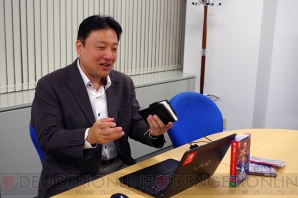
|
|---|
「どうしたんですか?」と話をしに行ったところ、「なかなかいい提案だけどタイトルを盛り上げるにはアイディアが欲しい」という雰囲気でした。そこで「これ、うちが作ったらどう思います?」と言ったところ、「インティさんが作るんだったら盛り上がりますよ」という話になり、弊社が作ることになりました。
――すごい話ですね。
実は、私がその場にいたのは一緒に米国に行っていたネイティブスタッフが腰痛を発症して動けなくなり、インタビューや打ち合わせがすべてキャンセルになってフリーになったからだったんですね。そこで知っている人と出会い、たまたま横で話を聞いていた。いろいろな奇跡が重なって開発することになりました。
当初、ニンテンドー3DSで作ることが企画として固まっている状態だったのですが、新ハード(後のNintendo Switch)が発表されるらしいというタイミングだったため、もしかしたらNintendo Switchに移植できるタイミングになるかもしれないという話になりました。ニンテンドー3DS版を作り始めていていき、その2カ月後の10月にNintendo Switchが発表されたので、すぐに移植のための機材を購入して、ローンチに間に合わせました。
――Nintendo Switchのローンチに発売され、注目度は高かったですね。
はい。日本ではローンチで出したということもあって、注目度が非常に高かったです。また、海外では今でもNintendo Switchのダウンロードタイトルは活発です。例えば8月のある週では、1週間に14本のインディータイトルが出た日があるんですね。そんなこともあり、さすがに目立たなくなりつつあるんですが、発売当時はすごく注目されました。
――ダウンロードゲームですが、値下げしてランキングが上がった時や、発売直後で注目が集まっている時は売れやすいのですが、そこから落ちた時、検索しか導線がなくてアピールが難しい一面もあります。デメリットとメリットをどのようにとらえられていますか?
まさに、今おっしゃられた通りのメリットとデメリットがあります。
弊社の場合、メリットとしては日本にありながら海外にも発売できることが一番大きいと思っております。要は、海外に輸出して流通する必要がなくて、ワールドワイドのストア上に置くことで、どこの国からも買えるようになります。このように商品をユーザーにお届けすることがすごく容易です。
また、店頭のように古いソフトでも棚落ちはしません。ランキングから落ちていっても、検索すれば出てきます。
デメリットは先ほどのように認知しなければ何が出ているのかわからないところ。そのため、どうやって認知させるかがキモだと思っておりますね。あと強いて挙げるならもう1つありまして……
――なんでしょう。

|
|---|
デメリットと言えるかわかりませんが、熱心なファンに何かしらのグッズを届けたいと思った時、ダウンロード販売ではなかなか届けられないことです。例えば「これを郵送しましょう」と言っても郵送代がかかりますから高くなってしまう。
それであれば、ソフトと一緒に流通さんにお願いしてユーザーに渡すのが適しています。そのため、熱心なファンに向けてアイテムつきソフトを販売しようとした時には、ダウンロード販売ではなくパッケージ版が適しています。ダウンロード版では、できてもテーマくらいです。

|
|---|
そのために弊社はインティ・ダイレクトというサイトを作ったり、海外では“Fangamer”というサイトに頼んでグッズを売ってもらったりしています。まあこちらは強いて挙げる要素なので、たいしたデメリットではないかもしれませんが。
プロモーションの手法について
――露出のデメリットを解消するために、どういうことをしているのでしょうか?
ダウンロード販売は、店頭に行って気になるソフトが並んでいたから買うという、いわゆるジャケ買いはありません。そのため、新規のユザーに訴求するのは非常に難しいことだと思っています。
まずはできることから……、ニコニコ生放送やTwitch、YouTubeでのインターネット配信で情報を伝える、あとはPVをこまめに作って出すこと。次いで、Twitter、Facebook、ブログなどのSNS展開をちゃんとやるようにしています。他には海外のイベントにできる限り行き、パネルで新しいビッグな情報を告知することをし、ファンとコミュニケーションをとりながらやっています。
私は、先ほど話に上がった『ショベルナイト』を作ったYacht Club Gamesさんを非常にリスペクトしています。彼らがやったことを真似たところから始まり、それをそのまま続けていったところに現状があるというイメージです。
――『ショベルナイト』とは『ガンヴォルト』と『ブラスターマスター』でコラボしています。それはリスペクトということで、持ちかけられたのでしょうか?

|
|---|
『ガンヴォルト』とのコラボは、日本版『ショベルナイト』が任天堂さんの販売で出るタイミングで話が進みました。その時、amiibo(アミーボ)を推しているタイミングだったので、「amiiboでコラボなんてどうでしょう?」と相談したところ、任天堂さまのニーズにマッチしたうえに、Yacht Club Gamesさんからも二つ返事でご快諾いただきました。
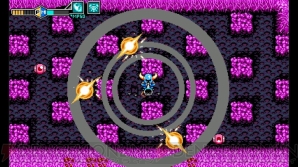
|
|---|
それがあったため、次の『ブラスターマスター ゼロ』でキャラクターコラボが成立しました。さらにいうと、その間に海外版のニンテンドー3DS版『Azure Striker GUNVOLT : STRIKER PACK』(『ガンヴォルト』の海外名)はYacht Club Gamesさんに流通をしてもらっているのです。
――そのような流れもあったんですね。
我々がダウンロード販売を検討していたら『ショベルナイト』を出されていたり、プロモーションでYacht Club Gamesさんを参考にしていたりするくらい、我々は彼らをリスペクトしているんですよね。
初めて彼らの会社にお会いしに行った時のことですが、夕方だったのでその後にみんなでディナーに行ったんですね。実は私がカプコン時代に『ブレス オブ ファイアII』を作っていたんですよと話すと、そのYacht Club Gamesのマネージメントをされている方が『ブレス オブ ファイア』の大ファンで、逆にリスペクトしてもらいました(笑)。
お互いに尊敬できる間柄であることがわかり、話に弾みがついたのもあるかなと思います。
――それまでに積み重ねてきたものが無駄にならないですよね。
私だけではないと思うのですが、それはあると思います。
今後のダウンロードゲームの行方は? Kickstarterの難しさとは?
――アプリ、コンシューマ、インディーと市場があって、ユーザーの動向はどうなっていくと考えていますか?
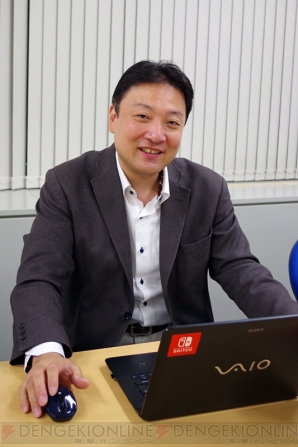
|
|---|
デバイス(プラットフォーム)や購入方法が違うだけで、ゲームを遊んでいる人はどれもそれぞれのルールで楽しんでいる。例えば、スマートフォンで無料アプリを課金して遊ぶおもしろさと、最初にお金を出してゲームを遊ぶおもしろさは、どちらかをやったからと言ってもう一方をやらないというものじゃないと思っているんです。
そこは共存できるものだと思っているんですが、お金のリソースには限りがあるじゃないですか。だから、100%コンソールに使えていたものが、2つに分かれれば半分になるというのはあると思いますね。
――あと、移動中に遊べても1日は24時間なので、どこかでゲームを遊ぶ時間はバッティングしますね。
頑張ってコンソールをやりながら、ローディング時間にアプリを遊ぶくらいですかね(笑)。
――自分たちでタイトルを手がけるようになり、発売後にもいろいろな展開をするようになりましたが、ユーザーとのやりとりで印象的だったことってありますか。
先に断っておくのですが、弊社が作ったゲームをパブリッシャーに売っていただくことに不満があるわけではありません。
そのうえで、自分たちの作ったゲームを自分たちで売るということは、最後まで責任を持つことだと思っています。例えば、買ってもらったあとのユーザーとのやりとりなどです。
何千円もかけて買っていただいたものを末永く遊んでもらいたいので、なるべくアップデートだったりDLCだったりを続けて、払い損だったと思われたくないというのはあります。購入した方の顔がより見えるようになって、アフターサービスをしっかりやりたいなと思うようにはなりました。
あとはどの国でも同じだと感じているのは、どこでイベントをやっても同じ顔が見られることです。
――ユーザーの喜ぶ顔ですか?
いえ、それもありますが同じ人が来てくれるということです。例えば東京でイベントをやって、大阪でもやって、名古屋でもやる。そうすると、どこにも来てくださる熱心なファンがいるんですね。国を超えて来るのはなかなか難しいんですけど、アメリカだったらロサンゼルスでやろうが、シアトルでやろうが、ポートランドでやろうが同じ顔が見える。要するに追いかけてきてくれてるということなんですよね。
弊社の行動を見て、行き先に来てくれる人々がいるのを見ると、「こういう人たちの気持ちを裏切ったらダメだ!」とすごく感じます。ただ、そこばかり見ていると広い視野がなくなるというか、切り捨ててしまう人たちが出てくることもあるので、ゲームを作る段階では意識せずに作っています。
――とはいえ、ありがたいですし心強いですね。

|
|---|
はい。あと、最近ニコニコ生放送などのインターネット配信を放送していますけど、コメントは本当にありがたいです。ありがたいことに弊社の配信はコメントがちょっと多めなんです。いつもコメントしていただいている方々がいるんだと思うのですが、本当に勇気づけられます。配信中は全部拾うことは難しいのですが、後ですべて見ています。
――御社はいろいろなことを自分たちでやられているので、メディアとしても学ぶことが多いです。
ただ、そこは方向性ですよね。メディアさんは広い層に訴求されて、メーカーはファンに向けて出していく。配信は、ファンとの距離を一気に縮めるものだと思っているので、しっかりと方向を間違えずに今後もやりたいと思っています。
――ダウンロードタイトルは、パッケージタイトルと並んで残っていくのでしょうか?
そうですね。今後どういう販売形態があるかを考えてくると、Amazonさんのように発展しているものもありますし、残ってはいくのですが、流通はかなりしぼられていくと思います。ではダウンロード販売以外に手軽に手元にゲームが来る方法を考えると、クラウドゲーミングという人もいます。ただ、もう少しレスポンスがよくなる必要があります。
あとは、コントローラやデバイスの問題があり、すべてのハードで同じゲームを遊べるようにならない。むしろコンソールプラットフォーマーさんは、コントローラに独自機構を付けて、その独自な機構での遊びがおもしろいというゲームをリリースされているのがうかがえます。
そういった傾向から考えると、もうしばらくはダウンロード販売を越えるゲームの届け方はちょっと思いつかないですね。
――最近気になっているタイトルや、遊ばれて画期的だったと感じたタイトルがあればお願いします。
最近では『Cuphead』ですね。あれはすごいですよ。

|
|---|
初めてあのタイトルを見たのはおそらく、3年くらい前でした。2014年くらいのGame Developers Conference(GDC)の近くでマイクロソフトさまがショーケース“ID@Xbox”をやっていたんですね。その一番奥の一番大きなスクリーンで『Cuphead』が動いていました。そのころ、情報を知らなかったので、「えらい丁寧に作っているな。たぶん好きな人が作っているんだろうな」と思ったんですよね。
で、それが毎年のようにそこに出ていて「いつ、このタイトルは出るんだろう?」と思っていたんですけど(笑)。
それがようやく発売され、出たらいきなり100万ダウンロードを突破したじゃないですか。「やっぱり丁寧に作ったゲームは評価されるよね」と思いました。ああいうちゃんと丁寧に作るところは見習いたいと思いました。
――会社としては納期や、販売目標があると思うんですけど、本当に作り込むだけ作り込んで、発売した時に一気に回収する方法は日本国内ではあまり考えられないのですが、それでもすごいと思いましたね。
利益率がすごく高くて、ある程度利益がしっかりあって、余裕があるならばそういう作り方をしたいんですけど……今の市場でそういう余裕を出していくのはなかなか難しいと個人的には思っています。アメリカによくあるエンジェル投資家ですか(笑)。そういう方がいればありかもしれないんですけど、なかなかそうはいかないです。
Kickstarterをやってみて難しいと思ったのは、その集金の構造自体です。Kickstarterで投資する人はユーザーだけでなく業界人も多いので、イニシャルゴールで高すぎる設定をすると見抜かれてしまい、それはきない。適切な金額でイニシャルゴールを設定して、あとはストレッチゴールで上げていくとなると、そのストレッチゴールに見合ったものを追加することになります。作るものが増えていくので、開発に余裕ができない。
※イニシャルゴール:プロジェクトが成立するために最低限必要な資金額。
※ストレッチゴール:イニシャルゴール以降、一定の金額が集まるたびに追加される拡張プラン。
――なるほど。
先に投資してもらってゲームを作るのは簡単ではないことを学びました。個人的な感想としては、イニシャルゴールを突破して、ストレッチゴールを1個くらい突破したようなタイトルのほうが、作りやすいのではないかなと思います。あくまで、個人的な感想なんですけど。
――『Cuphead』はあの作り込みがすごいですね。
レトロとは違って、ノスタルジックな感じなんですよね。ゲームでレトロと言うとドットだったりとかローポリゴンだったりとかするんですけど、そうではなくて絵作り、絵の中がノスタルジックというのは独自性があっていいと思うんですよね。ああいう絵は日本ではあまりないような気がします。
新たなダウンロードコンテンツを配信予定!?
――御社として今後はこれに頑張っていくという目標、告知などがあれば、お願いします。
やはり『ぎゃる☆がん2』になります。2018年3月15日の発売に向けて、いますごく頑張って作っています。やっぱりこれを遊んでいただきたいですね。
あと、弊社既存のタイトルも、DLCやアップデートを準備していますので、既存のタイトルをお持ちの方もお楽しみに。
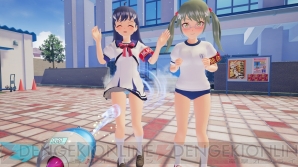
|
|---|
| ▲『ぎゃる☆がん2』 |
――どのタイトルでしょうか?
インティ・クリエイツが販売しているものだけになりますが、1つではなくていくつかあります。……発表をお待ちください。
――御社のDLCといえば、『ブラスターマスター ゼロ』が印象的でした。配信から2週間は無料で、それから有料というやり方。欲しいDLCにお金を出すのは個人的にためらわないのですが、この手法はいいと思いましたね。買っていなかった人が買うきっかけにもなりますし。

|

|
|
|---|---|---|
そこは工夫してやったところでもあります。『ブラスターマスター ゼロ』はただ配信することがインディっぽくないと思っていたんですね。これは私の“インディー感”であって、皆さんの考えるインディー感ではないかもしれないんですが。
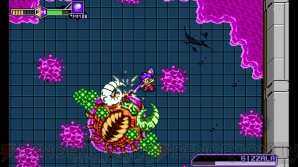
|
|---|
最初の“ガンヴォルト”と“えころ”だったので、自社タイトルとのコラボで別にどこも損はしない。その後に“シャンティ”と“ショベルナイト”でもやったのですが、こちらは他社様のIPになります。普通、自分のところのキャラクターを貸すのに、無料で配布していいというのはなかなかできないじゃないですか。
そこをWayForwardさんとYacht Club Gamesさんが気持ちよく「いいよ」と言ってくださったのは、やっぱりお互いにインディーパブリッシャ、ゲームメーカーとしてやっているからこそ、共通する思いがあったのではないかなと思っています。
――同じクリエイター同士、変には使われないだろうっていう信用もあったのかもしれませんね。
そうですね。もちろんキャラクターチェックはしてもらっていたのですが……デザインが間違っていることのないように、監修してもらうという感じ。変な見え方がしないように、確認という雰囲気ですね。
――他に告知はありますか?
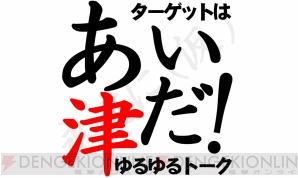
|
|---|
12月20日に生放送“あいつだ!”を配信いたします。2017年を振り返りつつ、インティ・クリエイツの新情報についてトークいたします。新しいコンテンツの試遊も予定しているので、ぜひご覧ください。
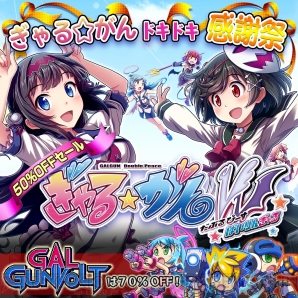
|
|---|
また、年末年始に向けて『ぎゃる☆がん』でセールがあるので、もしまだお買い求めいただいていない方はぜひ。来年も弊社ならびにタイトルをよろしくお願いいたします。
■“ゆるゆるトーク ターゲットはあい津だ!(仮)”第16回ゆく年くる年
【配信日時】2017年12月20日 21:00~
【出演・敬称略】會津卓也、津田祥寿
【配信】
ニコニコ動画(http://live.nicovideo.jp/watch/lv309488757)
Youtube Live(https://www.youtube.com/user/inticreates/live)
FRESH!(https://freshlive.tv/inticreates/177617)
Digital games have obtained citizenship... We talk about the state of the marketplace.(英訳版)
――To speak about indie games, there are a wide variety of titles, and there are as many ways to think about them. What is your way of thinking about them?

|
|---|
With just the word "indie," you have a huge variety of games tied together by one label. But for me, that vagueness is the great thing about indie games.
For example, you have a company like ours with a great deal of experience making console games and the development resources to make high quality games. In that same space, you also have mobile games developed entirely by a single person. All of that is included in the label of "indie" and I think that's great.
――Though it goes without saying, Inti Creates' games certainly are high quality.

|
|---|
Thank you very much. We are not a company that makes AAA games. Of the games we are hired to make, they are often aimed at younger players. However, we always take great care in developing those games.
The younger customers who will support the entire games industry in the future should be treated properly. There is a sense of danger that the entire industry could disappear, so it's important to develop those games for small children... Well, "Gal*Gun" is definitely not included there (laughs). But we do want to create games for that younger audience, so we take on projects from outside with that in mind.
――While that target might be easy to understand, I get the sense that reaching that audience can be difficult.
Promoting to small children is difficult, with expensive TV commercials and magazine promotions being necessary. As an indie, that's especially difficult. Indies tend to target an older audience.
――What are your feelings on the current marketplace for downloadble games?
It feels like they've earned their citizenship. Even now among users who prefer physical games, I believe there is a reason why digital games have been able to sell as well as they have. My reason would be smartphones.
――Apps?
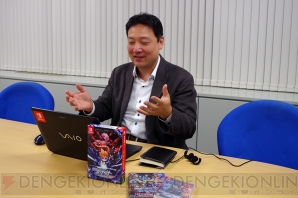
|
|---|
That's right. Smartphone games have no physical versions and are download-only. As users get more comfortable with those apps, it's not surprising that they eventually start to think, "Are digital games for consoles that bad?" While everyone is different, I think that barrier will eventually get broken down.
Also, with the Nintendo Switch and other handheld consoles, it's even more true, since carrying and changing cartridges or CDs on the go is especially annoying.
――I totally get that.
You can play a digital game anytime, anywhere. Also, for games that you boot up, play a bit and stop, progressing a little bit every day, it makes a lot of sense as a digital title.
――Personally, since the PS Vita, I've wanted to have a lot of different games available, so I find myself buying larger memory cards.
On that topic, lately games have really gotten large. You know, our game "Mighty Gunvolt Burst" is only about 40MB. Megabytes!(Laughs) Well, "Mighty Gunvolt Burst" was made with our new engine, so we were able to keep the size pretty small.

|
|---|
"Blaster Master Zero" is about 280MB... While it depends on the genre, for indie games, a 64GB or 128GB SD card would be plenty. Of course, for AAA games with lots of 3D, you'd need more space.

|
|---|
Players' smiles are the reason for digital games
――To return a bit, do you feel that the marketplace has changed since the coming of smartphones?
I believe it has changed considerably. The expanding smartphone marketplace and the shrinking console space is not just a future everyone can see, but our current reality.
As stores close, gamers will have less opportunity to buy games in person. Of course internet sales are a factor, but within that is a chance for digital titles as well.
Another factor is the increasing number of internet connected households. The barrier to buying digital games that players feel will begin to crumble and the market will establish itself firmly, or so I think. Actually, I'm not entirely confident it will work like that. (Laughs)
――When exactly was it that you thought, "We can make digital games work"?
When I saw how Steam was doing in America. A while ago, I was told that Steam was very popular and, "If you put your game on Steam, it'll sell." There are many people who buy PC games digitally.
In 2013, I went to PAX Prime in Seattle with Keiji Inafune when the Mighty No. 9 Kickstarter had just begun. We visited the Indie MEGABOOTH and saw many titles that looked just like old Japanese games. There were so many people who saw them and excitedly said, "I'm buying this! Wow!" to each other. And those games were all being sold on Steam.
At that time, we were developing "Azure Striker Gunvolt" for the Nintendo 3DS. We weren't developing for PCs and then porting it to 3DS; the 3DS was our target platform, so we couldn't produce a demo for a PC version at the drop of a hat. Because of that, the path to selling it on Steam would be difficult.
――I see.
Even though we learned that making and selling retro-style games on Steam was viable, it would be difficult for us. However, at that time, I heard that "Shovel Knight" was doing really well as a digital title on 3DS, so I thought, "Then let's try selling Gunvolt on the 3DS eShop," and that's the route we took.

|
|---|
――What was the reaction from customers when you announced that?
When we announced "Gunvolt," it had been a long time since a major company had released a 2D side-scrolling action game. With that, and our company's long history of creating games in that style, we received a lot of attention.
The genre has many fans overseas and in America, so the response there was amazing. We had expected it to an extent, but we were still a bit surprised.
――From my impression, it's a genre with many dedicated fans.
Certainly. However, there is a certain ratio of those dedicated fans worldwide.
For example, with the launch of the Nintendo Switch, we released "Blaster Master Zero" alongside it. To the best of my understanding, in North America, Europe, and Japan, the number of copies sold corresponded to a certain percentage of the total number of consoles sold in the respective region.
I realized it was more than, "It sold really well because of Japan," or "It sold really well because of North America and Europe," but rather that those fans of retro-style games exist as a fixed percentage of players in a region that doesn't change.
――About "Gunvolt," though the first title had a good reception, I recall that the second title didn't do very well... Was that true both in Japan and overseas?

|
|---|
Oh, my talk from "Tokyo Indie Fest." About that, please allow me to explain a bit. Domestically, "Gunvolt 2" sold well. As a direct story sequel from the previous game, it could be considered a success if it sold 70% of the previous game's sales. By that metric, it managed to sell over those expectations, so please don't worry.
At "Tokyo Indie Fest," the audience actually consists mostly of people from overseas. A large portion of the audience are resident Americans and foreigners watching on Twitch, so it was more appropriate to give a talk from that viewpoint. So, instead of speaking about domestic sales, I touched on the overseas sales figures.
Looking at overseas figures, in 2016, the Nintendo 3DS had largely stalled in sales. Because of that, 2014 and 2016 presented very different markets on the platform. In that environment, games selling on the Nintendo eShop faced a difficult struggle, and that is what I was speaking on.
――I see.
In overseas markets, the PS4 is growing. To that effect, we have data for the overseas sales of "Gal*Gun Double Peace." At that time, it wasn't just the PS4 version selling well, but the PS Vita version as well. And now overseas, the PS Vita has stalled, but the PS4 version still sells today.
Of course, the 3DS isn't the only reason for Gunvolt's slow sales. And the PS4 is only one factor for Gal*Gun's success. Another reason could be that overseas creators don't make games like Gal*Gun.
――You certainly don't see them.

|
|---|
You really don't. So when games like Gal*Gun are brought overseas without any changes, I believe they have a sort of freshness to them. UK-based publisher PQube sells Gal*Gun overseas for us, and we are very thankful for their efforts.
――You're also working together with them for "2".
Yes, we're working together this time, too. Those in the know may notice on the game homepage that it reads "Published by PQube."
The stars aligned for Blaster Master Zero!?
――"Blaster Master" is a popular game overseas, so it makes sense if it was targeted there, but did it perform as well in Japan?

|
|---|
As we expected, it did sell a certain amount in Japan. If we had released it domestically using the name "Meta Fight,"
it's possible it could have sold more, but that was a decision we reached together with Sunsoft (a brand owned by SUNCORPORATION). Eventually, we decided that naming the game "Meta Fight Zero" in Japan and "Blaster Master Zero" overseas would create confusion, even for informed customers, so we went with a single name worldwide. And due to its popularity overseas, we decided on "Blaster Master Zero."
Even so, there were people in Japan saying, "What is Blaster Master?" There was a plan for a PR campaign to inform customers that "'Blaster Master' is 'Meta Fight'," but that was such a roundabout way of promoting the game that we decided against it.
In the end, even without saying "Meta Fight," dedicated Meta Fight fans already know what "Blaster Master" is. If they don't, it's easy to figure out. For those fans, if they are still playing games, I'm sure they'd buy it as soon as they found out there was a new game in the series.
――To go back in time a bit, how did development on "Blaster Master Zero" come to start?
For brands, or rather IP (intellectual properties), simply holding them will cause fans to forget, and eventually they will die. Because of that, the names need to be used or similar games need to be made somewhat regularly. SUNCORP is very aware of this, so they were looking to reboot "Blaster Master" to keep the memory of it alive among gamers.
With that in mind, they were looking for someone to make a side-scrolling action-adventure game—practically a bullseye for us. We met through our Nagoya branch office, which belongs to the Game Academics and Industries Relationship Association (GAIRA) in Nagoya. There, we had the chance to meet with SUNCORP's staff directly who asked, "So, will you make it?" However, at the time our development team had their hands entirely full, so we told them, "We'll think about it," as a polite way of half-refusing (laughs).
――I see (laughs).
Some time after that, at E3 2015 in North America, I happened to pass a producer from SUNCORP on my way to breakfast. He was having trouble entering the meeting area to meet with Nintendo of America. By chance, I was able to help this acquaintance of mine get to where he needed to go.
After that, again on my way to the cafeteria, I passed by the table where SUNCORP and NOA were meeting. The meeting wasn't very lively, and was unexpectedly quiet. If the people meeting aren't excited, it can't go anywhere, right?
――That's true.

|
|---|
I later went to the producer and asked, "What happened?" He told me, "The proposal was fine, but we need more exciting ideas for the game." I asked, "What if we made it?" "If Inti made it, that'd be perfect!" We decided it just like that.
――It's an amazing story.
What's more, our native English staff who I was with on this trip had severe back pain and couldn't move at that time. So all the interviews and meetings we had needed to be canceled, and I was free all day. And during that time I ran into the producer and just happened to pass by that meeting. The stars aligned for this project to begin.
At the beginning, it was planned that the game would release on the Nintendo 3DS, but as the release of their new platform (Nintendo Switch) was coming soon and it seemed that we could match it, we decided to port it to Switch. We began development on the 3DS, and 2 months later in October the Nintendo Switch was announced. We immediately bought development kits and began work to release for launch.
――Releasing for the Nintendo Switch launch would get some attention.
Right. Releasing for launch in Japan certainly got it extra attention. Also, even now the Switch is a popular platform for digital titles. For example, in one week in August, 14 indie titles came out on the same day. Obviously, it's harder to stand out in those circumstances, so the release timing really helped.
――For digital games, it's easy to get attention with a sale or immediately after release, but after that, unless someone searches for the game, it's hard to connect to an audience. What is your perspective on the pros and cons?
For sure, those pros and cons are just like you said.
For us, the biggest pro is that it's easy to release both in Japan and overseas. Basically, we don't need to deal with export or distribution, and can release to digital storefronts worldwide ourselves. It's very easy to deliver our games to players this way.
Also, games remain available no matter how old they are. They may drop from rankings, but if you search, they are still there.
As for cons, like you said earlier, it can be difficult to for your game to be discovered by people who don't already know about it. I believe reaching these customers is essential. If I have to, there's one more thing I can think of...
――What is that?
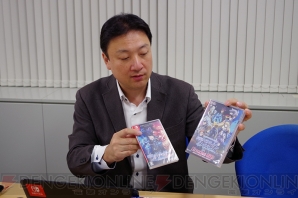
|
|---|
I don't know if you'd call this a con, but if you want to get physical items to customers, you can't really do that with digital games. Even if you say, "Let's ship this out," the postage gets expensive.
With physical games, you can ship items together with games through a distributor to deliver them that way. This way, for those dedicated fans who want physical items, a physical release makes more sense than a digital-only one. For digital games, the most you can do is something like a theme.

|
|---|
For us, we sell game-related products through our site Inti Direct in Japan, and through our partners at "Fangamer" overseas. So for us, it is not too much of a "con," only if I had to think of one.
What about promotion?
――What do you do to mitigate the problem of exposure?
With digital sales, customers can't visit a store, get interested in the game's cover on the shelf, and buy it on the spot. I think it can be difficult to attract new players because of this.
For things we can do, we stream on Niconico Video, Twitch, and Youtube, as well as making our own trailers. We also post regularly to social media such as Twitter, Facebook, and our blog. As much as possible, we attend events overseas and hold panels to reveal big announcements and communicate with fans.
In regards to those activities, I have much respect for Yacht Club Games, the creators of "Shovel Knight." We followed their example in the beginning to expand our outreach to where it is today.
――Shovel Knight has crossed-over into Gunvolt and Blaster Master Zero. Did you propose this due to that respect?

|
|---|
For the Shovel Knight crossover, we began discussing it around the time Nintendo was releasing Shovel Knight in Japan. They were promoting amiibo at that time as well, so the discussion became, "Why not do an amiibo feature?" This met Nintendo's needs as well, so Yacht Club Games quickly got on board.

|
|---|
Because of that, we were also able to do the Blaster Master Zero character crossover. Also, around that time we worked with Yacht Club Games to distribute the Nintendo 3DS "Azure Striker Gunvolt: STRIKER PACK" overseas.
――So that's how things went.
When doing research on digital games, Shovel Knight came up a lot, and we've also used Yacht Club Games as reference in promoting our games as well. We have much respect for them.
The first time our companies met, it was evening so we went out for dinner afterward. It came up that I had worked on Breath of Fire II while at Capcom, and one of Yacht Club's management was a big Breath of Fire fan. Ironically, I ended up getting the respect that time (laughs).
I believe having a relationship of mutual respect helps talks get off the ground faster.
――That way your efforts won't go to waste.
While they are not mine alone, I also feel that way.
What's next for digital games? What about the difficulty of Kickstarter?
――In mobile, mainstream, and indie game markets, where do you see players trending?

|
|---|
While the ways players purchase games on various platforms differ, they are still playing and enjoying those games just the same. For example, spending money on in-app purchases in a free game you enjoy doesn't mean you won't also play a game you pay for up-front.
While I believe the systems can coexist, there is always a limit to a player's money. Someone who used to spend all their money on console games might have to divide their spending when they pick up a new platform.
――Also, even if you're playing games on your commute, there are only 24 hours in a day. Different games are competing for that limited time.
If you're really pressed for time, you can play games on your phone while your console games are loading (laughs).
――As you manage development of your games and continue to develop them even after release, have you gotten any feedback from players?
While we decline to do so, it is not that we are entirely opposed to selling our games to a publisher.
However, we feel it is our responsibility to see the games that we have created entirely ourselves all the way through release and beyond. Communication with the people who bought our games is a part of that.
While we'd love it if the players who spent their own money to play our games could continue playing them forever, we also don't want anyone to feel burned buying our games, so we continue updating them and adding DLC. As we see the faces of our customers more and more, we want to properly support our games after release.
Whatever country I visit, no matter the event I go to, I get the same feeling when I see the same faces at events.
――You mean the players' happy faces?
No. While there is that, I'm referring to seeing the same people visiting us time and again. For example, we do events in Tokyo, Osaka and Nagoya. There are dedicated fans who come see us no matter where we are. Even though it's difficult to visit another country, in America, I'll see the same faces in Los Angeles, Seattle and Portland. It's like they're following us.
When I see those people who pay such close attention to where we go to come visit us, I feel strongly, "We can't betray these fans!" Although, if we were to focus only on those dedicated fans, our scope could become too narrow and we could leave other players behind. It's important to keep these things in mind when making games.
――Even so, it must be encouraging.
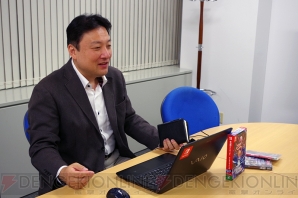
|
|---|
Of course. Also, lately during our live streams on Niconico and other places, I'm very thankful to those who take the time to comment. And while I'm thankful, there are kind of a lot of comments on our broadcasts. I believe there are people who always comment on our videos, and it's very encouraging. It's difficult to respond to all the comments while we're live, but I make sure to read them all afterward.
――Your company does so many different things on its own, as media we could learn a lot from you.
However, our aims our different, aren't they? For the media, your aim is to reach a wide audience, but as developers, we wish to reach our fans. With our streams, the distance between us and our fans is dramatically shortened, and I believe we should operate with this in mind.
――From physical to digital sales, is there anywhere left to go?
I wonder. Thinking about the form of sales from here, with the expansion of firms like Amazon, distribution is getting fairly locked down. So, outside of downloading games, some would say the next step in easily getting games to customers is cloud gaming. However, response times would need to come down a bit first.
Also, there is the problem of different controllers and devices. Every game is not playable on every platform. To console diehards, each controller has its own unique properties, and they would say games are made to take advantage of those specific properties.
With those considerations, I find it difficult to imagine a distribution method that can surpass digital sales.
――Of games you've played recently, are there any you would consider ground-breaking?
Recently, I would say "Cuphead." It is incredible.
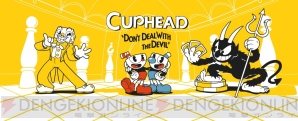
|
|---|
The first time I saw it was probably 3 years ago. In 2014, around the Game Developers Conference (GDC), Microsoft held their own showcase event called ID@Xbox. There, I saw Cuphead on the biggest screen way in the back. I didn't know anything about it, and thought to myself, "Wow, this is really well-made. It must be made by someone who loves these sorts of games."
And every year since then I've seen it there and thought, "When is this game finally coming out?" (laughs)
When it did come out, it almost immediately hit 1 million downloads. I thought, "So well-made games really do have a lot of value." I hope to follow the example of such a carefully-crafted game.
――I'm sure they had deadlines and sales targets, but being able to take your time to make the games you want, and recover funds as soon as the game is out would be unthinkable for a Japanese company; it really is amazing.
Since the margins are high, there is a lot of possible profit. I'd love to make games like that. However, in the current market, I personally think it is difficult to get the leeway to manage that. Maybe with one of those "angel investors" from America (laughs). Without one of those, you can't really operate like that.
In fact, collecting that money is why I think doing a Kickstarter is so difficult. Kickstarter investors are not only players, but also people in the industry, so by setting your initial goal too high, you risk being overlooked as being unrealistic. Setting your goal lower and promising more through stretch goals can bring in more money, but then you need to add on to the game. Adding more features will make the schedule tougher and you won't get that leeway.
――I see.
I learned that getting the money to make a game up-front isn't so simple. Personally, I think a game that reaches it's initial goal and about one stretch goal would be easier to make. That's just my impression, though.
――Cuphead's craftsmanship is something else.
It has a nostalgia that's different from other retro games. Retro games usually have pixel sprites or low-polygon counts, but its crisp animations and artwork with a different nostalgic quality make it very original. You don't see artwork like that much in Japan.
Plans for new DLC?!
――Do you have anything to announce regarding your company's current goals?

|
|---|
That would have to be "Gal*Gun 2". We're currently working very hard to get it ready for its March 15th, 2018 release date. Of course, I'd love for people to play it.
Also, we're working on DLC and updates for recent games, so for people who already have those, please look forward to that.
――What games would those be?
It's only games that we have released by ourselves, but there a few of them. ... You'll have to wait for the announcements.
――Speaking of your DLC, Blaster Master Zero's are impressive. They are free for 2 weeks after release, and become paid after that. Personally, I wouldn't hesistate to pay for DLC I wanted, but I think this is a great method. It's a good chance even for people who haven't yet bought the game.

|

|
|
|---|---|---|
That was part of our plan. I didn't feel releasing Blaster Master Zero alone was very "indie." Of course, this was just my way of thinking, and everyone has a different idea of what "indie" means.

|
|---|
At first, with "Gunvolt" and "Ekoro," we were using our own characters so it wasn't a problem. After that, with "Shantae" and "Shovel Knight," we were using IP from other companies. Normally you wouldn't lend someone else your characters and let them be released for free.
However, we got an emphatic "Okay" from both WayForward and Yacht Club Games. I feel this was the spirit of our cooperation as fellow indie publishers and game makers coming through.
――It may have been a trust as fellow creators that you wouldn't mistreat their characters.
That's right. Of course they checked everything themselves as well...making sure the designs were correct and doing other supervision, so that they wouldn't look out of the ordinary at all.
――Any other announcements?

|
|---|
We have our "Aitsuda" livestream on December 20th. We'll be looking back on 2017 as well as talking about some new information. We plan on trying out some new gameplay as well, so please check it out.

|
|---|
Also for the new year, we're having a "Gal*Gun" related sale, so for anyone interested in purchasing, please take a look. Please support our games next year as well.
(C)INTI CREATES CO., LTD. 2017 ALL RIGHTS RESERVED.
(C)INTI CREATES CO., LTD. (C)SUNSOFT
SUNSOFTは、サン電子株式会社の登録商標です。
(C)2017 Yacht Club Games LLC. SHOVEL KNIGHT and the Shovel Knight character are trademarks of Yacht Club Games LLC. All rights reserved.
(C)INTI CREATES CO., LTD. 2016 ALL RIGHTS RESERVED.
(C)2016 Yacht Club Games LLC. Shovel Knight and the Shovel Knight character are trademarks of Yacht Club Games LLC. All rights reserved.
(C)INTI CREATES CO., LTD. 2014 ALL RIGHTS RESERVED.
(C)INTI CREATES CO,. LTD. 2015,2016 All Rights Reserved.
Published by PQube Ltd.
(C)INTI CREATES CO,. LTD. ALL RIGHTS RESERVED.
(C) 2017 | Studio MDHR
データ